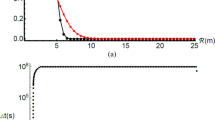Abstract
The aim of the present study is to model mixing and transport of radioactive effluents in the course of time between two water reservoirs. To test the model, a hypothetical case study is presented of liquid effluents potentially released during normal operation of a fusion neutron source devoted to radioisotopes production. A suitable example is an accelerator-driven intense D-T 14 MeV neutron source relying on T and D ion beams, with the potential to provide a neutron yield in the range \( 5{-}7 \cdot 10^{13}\) s-1. It is expected that during normal operation a number of radionuclides will be produced and managed. The present report discusses the mechanisms and parameters which affect and control the fate of radionuclides potentially released into two connected water reservoirs during normal operation of the plant. A mathematical mixing model is developed that describes groundwater flow and radioactive transport between the two basins. The aim of this study is to estimate the amount of radioactivity concentration in both water reservoirs at any time, an information that can be used for radiation protection purposes.





Similar content being viewed by others
References
D. Flammini, R. Bedogni, F. Moro, A. Pietropaolo, On the slowing down of 14 MeV neutrons. J. Neutron Res. 22(2020), 249–256 (2020)
M. Capogni, A. Pietropaolo, L. Quintieri, M. Angelone, A. Boschi, M. Capone, N. Cherubini, P. De Felice, A. Dodaro, A. Duatti, A. Fazio, S. Loreti, P. Martini, G. Pagano, M. Pasquali, M. Pillon, L. Uccelli and A. Pizzuto“, 14 MeV Neutrons for 99Mo/99mTc Production: Experiments, Simulations and Perspectives”, Molecules (2018), 23: 8, (1872)
T.J. Ruth, The shortage of technetium-99m and possible solutions. Ann. Rev. Nuc. Part. Sci. 70, 77–94 (2020)
G.M. Contessa, M. D’Arienzo, M. Frisoni, P. Ferrari, R. Panichi, F. Moro, A. Pietropaolo, Preliminary evaluations of the environmental impact for the production of 99Mo by fusion neutrons. Eur. Phys. J. Plus (2021). https://doi.org/10.1140/epjp/s13360-021-01404-0
Generic Models for use in assessing the impact of discharges of radioactive substances to the environment, safety Reports Series No. 19, IAEA, Vienna (2001)
Report No. 123. Screening Models for Releases of Radionuclides to Atmosphere, Surface Water, and Ground - Vol. I and Vol II. NCRP, Bethesda (1996)
E. Kreyszig, Advanced Engineering Mathematics (John Wiley & Sons, New York, 2006)
IAEA-TECDOC-1314, Radionuclide transport dynamics in freshwater resources Final results of a Co-ordinated Research Project, 1997–2000 (2002)
Author information
Authors and Affiliations
Corresponding author
Rights and permissions
About this article
Cite this article
D’Arienzo, M., Malizia, A. & Contessa, G.M. Modelling mixing and transport of radioactive effluents in water reservoirs: an application to the operation of a fusion facility. Eur. Phys. J. Plus 136, 1045 (2021). https://doi.org/10.1140/epjp/s13360-021-01771-8
Received:
Accepted:
Published:
DOI: https://doi.org/10.1140/epjp/s13360-021-01771-8




